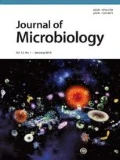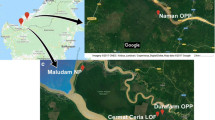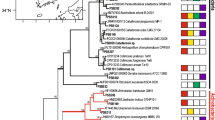Abstact
The fungus Tricholoma matsutake forms an ectomycorrhizal relationship with pine trees. Its sporocarps often develop in a circle, which is commonly known as a fairy ring. The fungus produces a solid, compact, white aggregate of mycelia and mycorrhizae beneath the fairy ring, which in Japanese is called a ’shiro’. In the present study, we used soil dilution plating and molecular techniques to analyze the bacterial communities within, beneath, and outside the T. matsutake fairy ring. Soil dilution plating confirmed previous reports that bacteria and actinomycetes are seldom present in the soil of the active mycorrhizal zone of the T. matsutake shiro. In addition, the results showed that the absence of bacteria was strongly correlated with the presence of T. matsutake mycorrhizae. The results demonstrate that bacteria, especially aerobic and heterotrophic forms, and actinomycetes, are strongly inhibited by T. matsutake. Indeed, neither bacteria nor actinomycetes were detected in 11.3% of 213 soil samples from the entire shiro area by culture-dependent methods. However, molecular techniques demonstrated that some bacteria, such as individual genera of Sphingomonas and Acidobacterium, were present in the active mycorrhizal zone, even though they were not detected in soil assays using the dilution plating technique.
Similar content being viewed by others
References
Barns, S.M., Cain, E.C., Sommerville, L., and Kuske, C.R. 2007. Acidobacteria phylum sequences in uranium-contaminated subsurface sediments greatly expand the known diversity within the phylum. Appl. Environ. Microbiol. 73, 3113–3116.
Dwass, M. 1960. Some k-sample rank-order tests, pp. 198–202. In Olkin, I., Ghurye, S.G., Hoeffding, W., Madow, W.G., and Mann, H.B. (eds.), Contributions to Probability and Statistics, Stanford University Press, USA.
Fitter, A.H. and Garbaye, J. 1994. Interactions between mycorrhizal fungi and other soil organisms. Plant Soil 159, 123–132.
Garbaye, J. 1994. Tansley Review No. 76: Helper bacteria: a new dimension to the mycorrhizal symbiosis. New Phytol. 128, 197–210.
George, I.F., Liles, M.R., Hartmann, M., Ludwig, W., Goodman, R.M., and Agathos, S.N. 2009. Changes in soil Acidobacteria communities after 2,4,6-trinitrotoluene contamination. FEMS Microbiol. Lett. 296, 159–166.
Hoshino, T.Y. and Matsumoto, N. 2007. Changes in fungal community structure in bulk soil and spinach rhizosphere soil after chemical fumigation as revealed by 18S rDNA PCR-DGGE. Soil Sci. Plant Nutr. 53, 40–55.
Kataoka, R. and Futai, K. 2009. A new mycorrhizal helper bacterium, Ralstonia species, in the ectomycorrhizal symbiosis between Pinus thunbergii and Suillus granulatus. Biol. Fertil. Soils 45, 315–320.
Khetmalas, M.B., Egger, K.N., Massicotte, H.B., Tackaberry, L.E., and Clapperton, M.J. 2002. Bacterial diversity associated with subalpine fir (Abies lasiocarpa) ectomycorrhizae following wildfire and salvage-logging in central British Columbia. Can. J. Microbiol. 48, 611–625.
Kikuchi, J. and Futai, K. 2003. Spatial distribution and the biomass of ectomycorrhizas of Suillus pictus in a Korean pine (Pinus koraiensis) stand. J. For. Res. 8, 17–25.
Kretzer, A., King, Z., and Bai, S. 2009. Bacterial communities associated with tuberculate ectomycorrhizae of Rhizopogon spp. Mycorrhiza 19, 277–282.
Lane, D.L. 1991. 16S/23S rRNA sequencing, pp. 115–175. In Stackebrandt, E. and Goodfellow, M. (eds.), Nucleic acid techniques in bacterial systematics, West Sussex: John Wiley and Sons, England.
Leys, J., Ryngaert, A., Bastiaens, L., Verstraete, W., Top, M.E., and Springael, D. 2004. Occurrence and phylogenetic diversity of Sphingomonas strains in soils contaminated with polycyclic aromatic hydrocarbons. Appl. Environ. Microbiol. 70, 1944–1955.
Mogge, B., Loferer, C., Agerer, R., Hutzler, P., and Hartmann, A. 2000. Bacterial community structure and colonization patterns of Fagus sylvatica L. ectomycorrhizospheres as determined by fluorescence in situ hybridization and confocal laser scanning microscopy. Mycorrhiza 9, 271–278.
Muyzer, G., De Waal, E.C., and Uitterlinden, A.G. 1993. Profiling of complex microbial populations by denaturing gradient gel electrophoresis analysis of polymerase chain reaction-amplified genes coding for 16S rRNA. Appl. Environ. Microbiol. 59, 695–700.
Ogawa, M. 1975a. Microbial ecology of mycorrhizal fungus, Tricholoma matsutake Ito et Imai (Sing.) in pine forest I Fungal colony (shiro) of Tricholoma matsutake. Bulletin of the Government Forestry Experimental Station Tokyo 272, 79–121.
Ogawa, M. 1975b. Microbial ecology of mycorrhizal fungus, Tricholoma matsutake Ito et Imai (Sing.) in pine forest II Mycorrhiza formed by Tricholoma matsutake. Bulletin of the Government Forestry Experimental Station Tokyo 278, 21–49.
Ogawa, M. 1977. Microbial ecology of mycorrhizal fungus, Tricholoma matsutake Ito et Imai (Sing.) in pine forest I The shiro of T. matsutake in the fungal community. Bulletin of the Government Forestry Experimental Station Tokyo 297, 59–104.
Ohara, H. 1966. Antibacterial activity of mycorrhiza of Pinus densiflora formed by Tricholoma matsutake. Proc. Jpn. Acad. 42, 503–506.
Ohara, H. 1980. Bacterial population in the shiro of Tricholoma matsutake and its allied species II. Bacterial behaviour in the shiro of T. matsutake under various forest conditions. Doshisha Women’s College of Liberal Arts, Annual Reports of Studies 31, 240–269.
Ohara, H. and Hamada, M. 1967. Disappearance of bacteria from the zone of active mycorrhizas in Tricholoma matsutake (S. Ito et Imai) Singer. Nature 213, 528–529.
Olsson, P.A., Chalot, M., Baath, E., Finlay, R.D., and Saderstriim, B. 1996. Ectomycorrhizal mycelia reduce bacterial activity in a sandy soil. FEMS Microbiol. Ecol. 21, 77–86.
Rantsiou, K., Urso, R., Iacumin, L., Cantoni, C., Cattaneo, P., Comi, G., and Cocolin, L. 2005. Culture-dependent and -independent methods to investigate the microbial ecology of Italian fermented sausages. Appl. Environ. Microbiol. 71, 1977–1986.
Steel, R.G.D. 1960. A rank sum test for comparing all pairs of treatments. Technometrics 2, 197–207.
Uroz, S., Calvaruso, C., Turpault, M.P., Pierrat, J.C., Mustin, C., and Frey-Klett, P. 2007. Effect of the mycorrhizosphere on the genotypic and metabolic diversity of the bacterial communities involved in mineral weathering in a forest soil. Appl. Environ. Microbiol. 73, 3019–3027.
Yamada, A., Maeda, K., Kobayashi, H., and Murata, H. 2006. Ectomycorrhizal symbiosis in vitro between Tricholoma matsutake and Pinus densiflora seedlings that resembles naturally occurring shiro. Mycorrhiza 16, 111–116.
Author information
Authors and Affiliations
Corresponding author
Rights and permissions
About this article
Cite this article
Kataoka, R., Siddiqui, Z.A., Kikuchi, J. et al. Detecting nonculturable bacteria in the active mycorrhizal zone of the pine mushroom Tricholoma matsutake . J Microbiol. 50, 199–206 (2012). https://doi.org/10.1007/s12275-012-1371-7
Received:
Accepted:
Published:
Issue Date:
DOI: https://doi.org/10.1007/s12275-012-1371-7




